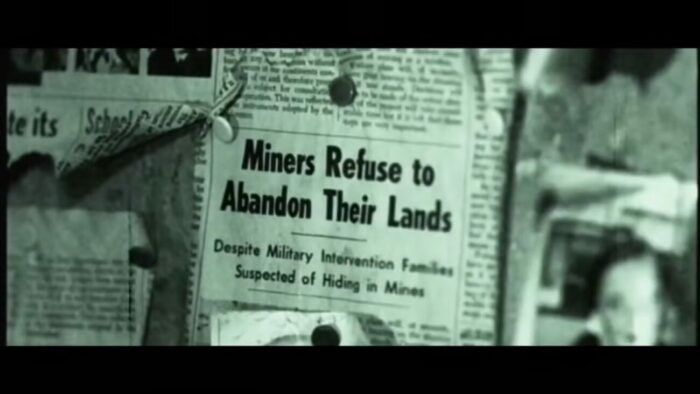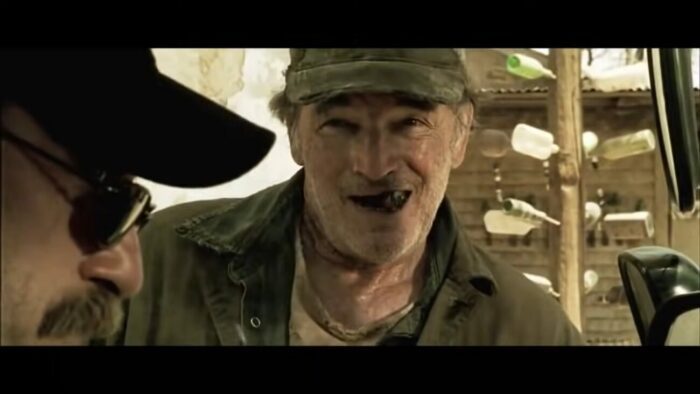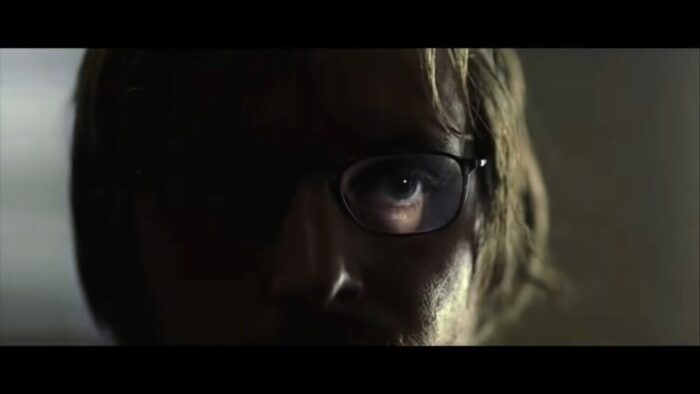Two mid-aughts Slasher Saturdays in a row?! Who’d have thunk it? Suppose you’ve been following my articles or the Slasher Saturdays column. In that case, you’ll be fully aware of my love for chasing the nostalgia dragon of the feeling of watching AMC’s FearFest or SciFi’s 31 Days of Halloween from when I was younger. Fret not, I will not spend a whole opening paragraph talking about it, as I am one to do. In recent weeks/months I have been going back through some of these mid-aughts films I grew up on and made a surprising and possibly controversial discovery. Could The Hills Have Eyes (2006) be an example of a perfect remake (and is it better than the original)? I wager to say yes.

Wes Craven’s The Hills Have Eyes was released in July of 1977 and would make around two million dollars by October of that year. By the end of its run, it would make 25 million, on a budget of between 350k and 700k. As well as being critically received fairly well, The Hills Have Eyes was not just a successful feature film, but it would go on to have a deep cult following. Cut to the early 2000s. Wes Craven noticed how successful the remakes of The Texas Chainsaw Massacre and The Amityville Horror were. This led him to consider a remake of his second feature film The Hills Have Eyes. Craven’s producing partner Marianne Madalena would then introduce him to the New French Extremity film High Tension. Luck is when preparation meets opportunity and Alexandre Aja was incredibly well prepared. With a budget of 15 million, six times bigger than that of High Tension, Aja and cowriter/collaborator Grégory Levasseur would venture deep into a Moroccan desert to start production.
KNB EFX spearheaded the six-month-long process of creating the mutant designs. Starting with elaborate 3D renderings, then onto sculptures, before ending with the incredible practical designs we see in the film. The first big change we should talk about is the antagonists and by proxy the harbinger. In the original Fred (John Steadman) acts as a harbinger and is actively trying to save the family from the group of cannibal savages. The remake brings us Jeb (Tom Bower) who, like Fred, is trying to escape the group of mutated cannibals, but still ultimately sends the protagonists to their doom. Fred does find himself to be more of a tragic character, he’s thrust unwillingly into the grips of the cannibal killers and has finally had enough. Jeb’s character actively helps the mutated cannibals to secure food and in return, they provide Jeb with their riches. When it comes to deaths, Fred’s is fairly tame, while Jeb’s shotgun to the head is way more impactful and tragic.
Cannibal savages versus mutated cannibals. Who wins? Craven’s Hills takes an American look at the class divide system. On one hand, we have the 2nd Amendment more wealth than needed suburbanites who are thrust into a world they don’t know, while the savages represent the lower class. It’s a harsh look at economic inequality, and while sometimes it feels a bit offensive in portrayal I think Craven does a decent job at telling that specific story. Aja’s Hills is a much more unique approach to the story. Rather than an American looking at class structure in America, we have a French filmmaker who is providing a commentary on how he sees the American cultural divide as an “outsider”. Aja’s depiction provides a lot more to the commentary of the idea of rich vs. poor than Craven’s does. Beyond that, it’s incredibly interesting to see how American political issues are viewed by someone who doesn’t live here.

There is unique violence in both of the films, and the majority of the kills are either one-to-one or nearly similar to each other. That is up until the stories completely diverge from each other. Both films have Doug (Martin Speer in ’77 and Aaron Stanford in ’06) portrayed as a bit of a, what a chud would refer to as, beta, but Aja goes a bit harder on that. The turn from beta to savior is one of the most intriguing in horror history, but how the respective films handle it is wildly different. Wes Craven handles the character of Doug pretty haphazardly and I don’t think it works. Shortly after the RV crash, Doug journeys off in the opposite direction of Big Bob (Russ Grieve) in hopes of finding a military base that’s on the map. From that point, Doug disappears from the film for a fairly decent amount of time before coming back to save the family. Aja’s Doug is a bit different.
If you know High Tension then you know what Aja can do. It’s an unflinching look at repressed sexuality and mental health. As someone who helped New French Extremity make a name for itself, it would make sense whatever project he took on next would fall into a political horror realm. In Hills ’06 we see a different Doug that also gives him top billing since he’s really the main character. After the crash, Big Bob (Ted Levine) and Doug decide they will both go separate ways to find help. When it’s brought up about whether Doug should take a gun, Big Bob makes a quip about how Doug is a Democrat and doesn’t like guns, making it clear that Bob is a Republican and Doug is a Democrat. Funnily enough Big Bob goes to the left, the familiar direction where there is a “known” outcome, while Dough goes to the right, placing Doug into unknown territories. Once Doug is back, his baby is kidnapped, he flips his switch…and that’s where the commentary really comes in. But we need to back up real quick.
In Craven’s script, there are two German Shepards: Beauty and The Beast. Aja and Levasseur’s script thankfully removes “the” from Beast’s name, because The Beast was a bit too on the nose. In both films, Beauty dies. Also in both scripts, Beast is there for the bloody denouement, but in each capacity, it’s handled differently. In Craven’s version, The Beast helps defeat Pluto (Michael Berryman). In Aja’s Beast does help a bit, but he’s more there for the symbolism. By the end of the film, we have seen the death of Beauty, literally and figuratively. These blue-blooded Americans have their eyes opened up to one of the unfortunate truths of life: there are evil people out there who only want to do you harm. Doug marches into the valley to save his daughter, led on a leash by Beast. Then after the action, we see a blood-soaked Doug walking out of the valley with his baby in one arm, and led by Beast with the other. The innocence of left-wing Doug has been ripped away from him and push has now come to shove. I think this really brings the whole ideology of New French Extremity to the forefront and really encapsulates the idea of the movement. When faced with powerful people enacting fascistic regimes, you fight back with what you can. For Aja, it’s with a camera, and for Doug, it was with the sharp end of a lawn stake with an American flag on it.
While Craven’s Hills is a fairly decent film with a good story, it’s Aja’s Hills that really takes the story and runs. The story, violence, practicals, and mood are all amped up by a thousand percent. So what makes this a perfect remake? Saying it’s because of practicals, mixed with digital enhancement would be cheating, so don’t worry about that. But it’s what Aja did with the source material and how he, and Levasseur, elevated it. It’s that Aja and Levasseur added a whole new element of commentary into what some might consider a throwaway mid-aughts slasher flick. The story isn’t very complex in either, but what Aja and Levasseur add in commentary makes the film feel fuller and rounded out in a way Craven wasn’t able to. It probably helps that Aja’s style fits perfectly in that zeitgeist of film. This was Craven’s second feature film, and he still hadn’t really formed a visual style so his films feel a bit all over the place. (Also I love Wes Craven, don’t get me wrong.) Coincidentally this was Aja’s second feature film and he had already crafted and understood what his style was, and it really works well in a story like The Hills Have Eyes.

So the question is what makes a remake good? Most of the time when a film is remade it’s because there’s some sort of intrinsic factor to it that audiences connect with. It’s fairly clear The Hills Have Eyes was not only financially successful, 25 million in ’77 money would be about 126 million in today’s money, but it gained a deep cult following. But to be a good remake you have to bring something new to the table, while also appeasing the fans of the original. The Hills Have Eyes ’06 not only kept incredibly close to the original while still being able to find its footing to stand on its own. The small change with Beast, the over-the-top nature of the violence, and the many minute additions and changes help take the remake from being a good movie to a great movie.



